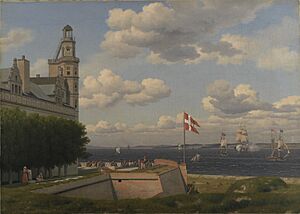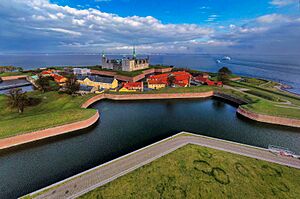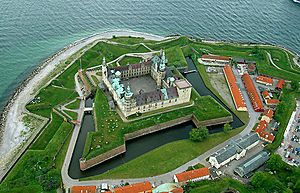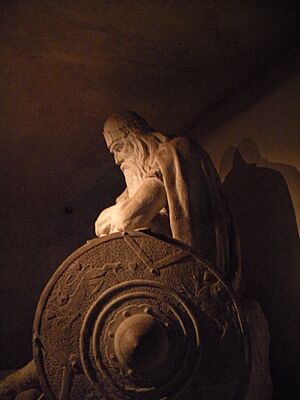Kronborg facts for kids
| UNESCO World Heritage Site | |
|---|---|
 |
|
| Location | Helsingør, Denmark |
| Criteria | Cultural: iv |
| Inscription | 2000 (24th Session) |
Kronborg Castle is a famous castle and historic fortress in Helsingør, Denmark. It is known worldwide as "Elsinore" from William Shakespeare's play Hamlet. Kronborg is one of the most important Renaissance castles in Northern Europe. Because of its unique history and architecture, it was added to the UNESCO World Heritage List in 2000.
The castle sits on the very tip of the island of Zealand. This spot is the narrowest part of the Øresund, a strait between Denmark and Sweden. At this point, the strait is only about 4 kilometers (2.5 miles) wide. This made the castle's location very important for controlling ships. It guarded one of the few ways to enter or leave the Baltic Sea.
The castle's story began with an older fortress called Krogen. This was built in the 1420s by King Eric VII. Later, from 1574 to 1585, King Frederick II completely changed the old fortress. He turned it into the amazing Renaissance castle we see today.
In 1629, a big fire destroyed much of the castle. But King Christian IV quickly had it rebuilt. In 1658, Swedish forces attacked and captured Kronborg. They took many valuable art treasures from the castle. In 1785, the castle stopped being a royal home. It was then used as barracks for the Danish Army. The Army left in 1923. After a lot of restoration work, the castle opened to the public.
History of Kronborg Castle
The First Fortress: Krogen
The story of Kronborg Castle starts with a fortress called Krogen. This name means 'the Hook'. It was built in the early 1400s by the Danish king, Eric of Pomerania. The king wanted all ships passing through the Øresund strait to pay a special fee called "sound dues." To make sure ships paid, he built this strong fortress at the narrowest part of the strait. At that time, Denmark controlled both sides of the Øresund. This meant Denmark could control all ships sailing through the strait.
Krogen was built on a sandy piece of land that stretched into the sea. The fortress had a square outer wall with several stone buildings inside. The king's home was in the building in the northeast corner. A large banquet hall was in the southwest building. The chapel was likely in the southeast corner. Many parts of Krogen's original walls are still part of Kronborg Castle today. Later, in 1558–1559, King Christian III added strong bastions (parts of the wall that stick out) to the corners.
Frederick II Builds Kronborg
Over time, new military weapons like powerful cannons made it clear that Krogen needed to be updated. After a war ended in 1570, King Frederick II began to improve the fortress. He added advanced bastions to protect the older walls. The main architect for this work was Hans Hendrik van Paesschen. The improvements were finished in 1577. After this, the castle was given its new name: Kronborg, which means 'Crown Castle'.
The castle itself was rebuilt from 1574 to 1585. The separate buildings of Krogen were connected to form three main wings. The north wing had rooms for the king, queen, and her ladies-in-waiting. The south wing had a modern chapel. King Frederick II loved theater, and plays were performed at the castle when he was there.
At first, the castle was only two stories high. But in 1578, a new architect named Anthonis van Obbergen was hired. He made Kronborg even bigger and grander. The south wing was made taller, and a huge ballroom was built above the chapel. Soon after, the west and north wings were also made taller. Finally, the east wing was also raised, and a special walkway called 'The Queen's Gallery' was added. This allowed the Queen to easily go from her rooms to the ballroom. The outside walls were covered with sandstone, and the new castle had a roof made of copper.
The Fire of 1629
In 1629, a fire accidentally started by two workers destroyed much of the castle. This happened on the night of September 24-25. Only the chapel was saved because of its strong arched ceiling. King Christian IV worked hard to restore the castle. The rebuilding started in 1631, led by architect Hans van Steenwinckel the Younger. By 1639, the outside of the castle looked magnificent again. However, the inside never fully regained its original splendor. Some parts were updated in the Baroque style, including new doorways, fireplaces, and ceiling paintings.
Swedish Capture in 1658
During the war between Denmark and Sweden from 1658 to 1660, Kronborg was attacked and captured by the Swedish army. This army was led by Carl Gustaf Wrangel. During the Swedish occupation, the Queen of Sweden, Hedvig Eleonora of Holstein-Gottorp, and the Swedish king's sister lived at Kronborg.
When the Swedes took over, Kronborg lost many of its most valuable artworks. These included a beautiful fountain in the castle courtyard. Also lost were King Frederick II's special canopy and many large ceiling paintings that King Christian IV had ordered for the ballroom.
Kronborg as a Fortress and Prison
The Swedish capture of Kronborg in 1658 showed that the castle was not as strong as people thought. After this, its defenses were greatly improved. From 1688 to 1690, a new advanced defense line called the Crownwork was added. Soon after, new walls were built around it. Once these were finished, Kronborg was considered the strongest fortress in Europe.
From 1739 until the 1900s, Kronborg was used as a prison. Soldiers living in the castle guarded the prisoners. These prisoners were forced to work on the castle's defenses. They were divided into two groups: "honest" prisoners with minor sentences could work outside the walls. "Dishonest" prisoners, who had committed serious crimes, had to do hard physical labor inside the castle. All prisoners had to wear chains and spend nights in cold, damp dungeons.
As Kronborg became less important as a royal castle, the military played a bigger role. From 1785 to 1922, the castle was completely managed by the military. During this time, several parts of the castle were renovated.
Sound Dues and Modern History
The "sound dues" were fees paid to the King of Denmark by every ship sailing through the strait. The amount depended on the value of the ship's cargo. The king had the right to buy the cargo for the price the captain stated. This rule stopped captains from saying their cargo was worth too little. The Royal Danish Army left the castle in 1923. After a lot of careful renovation, Kronborg Castle opened to the public in 1938.
Kronborg Castle Today
Kronborg Castle is located at the very northeastern tip of the island of Zealand. It is just northeast of the historic town of Helsingør. The castle sits on a small piece of land that sticks out into the narrowest part of the Øresund strait. This strait is between the Danish island of Zealand and the Swedish region of Scania. The main entrance from the town is to the east. A series of moats (water-filled ditches) and gates protect the path from the town to the castle.
Royal Apartments
The royal apartments are on the first floor of the north wing. Frederick II first furnished these rooms around 1576. After the 1629 fire, Christian IV had them redecorated. They were richly adorned with ceiling paintings, stone doorways, and fireplaces. Today, these rooms have furniture from the 1600s.
The King's Chamber has a special window that sticks out. It is right above the castle's main entrance. From here, the king could watch guests arriving. The Queen's Chamber has a vaulted tower room that looks out over the Flag Bastion.
The Grand Ballroom
When it was finished in 1582, the Ballroom was the largest hall in Northern Europe. It measures 62 meters (203 feet) long and 12 meters (39 feet) wide. The walls are decorated with large paintings. These paintings were originally made for the Great Hall of Rosenborg Castle in Copenhagen between 1618 and 1631. The paintings in the Ballroom show scenes like 'Children off to School' and 'A Wedding in a Church'. The current floor and fireplaces were added during the rebuilding work from 1924 to 1938.
The Little Hall
The walls of the Little Hall are decorated with seven tapestries. These tapestries are part of a larger series of forty that showed one hundred Danish kings. These amazing artworks include a tapestry showing King Oluf (1376–1387) and another showing King Knud VI (1182–1202). King Frederick II ordered these tapestries around 1580. Seven more tapestries are at the National Museum of Denmark, but the rest have been lost over time.
The Chapel
The chapel is on the ground floor of the south wing. It was first opened in 1582. In 1785, when the castle became army barracks, the chapel was turned into a gym and fencing hall. Its furniture was stored away. The chapel was refurnished with its original items in 1838 and reopened in 1843.
Cultural Importance
Kronborg and Hamlet
Kronborg Castle is famous as "Elsinore" in William Shakespeare's play Hamlet, Prince of Denmark. The play has been performed at the castle many times.
The first time Hamlet was performed at Kronborg was in 1816. This was to celebrate 200 years since Shakespeare's death. Soldiers from the castle garrison performed it. Since then, the play has been staged many times in the castle courtyard and on its walls. Famous actors who have played Hamlet at the castle include Laurence Olivier, John Gielgud, and Jude Law.
Ogier the Dane
There is a legend about a Danish hero named Ogier the Dane (in Danish, Holger Danske). The story says he was taken to a magical place called Avalon. Ogier returned to save France from danger. Then, he traveled to Kronborg Castle. Here, he sleeps until Denmark needs him to save the country. His beard has grown so long it stretches along the ground. A statue of the sleeping Ogier is placed in the castle's underground rooms, called casemates.
Culture Harbour Kronborg
Kulturhavn Kronborg is a project started in 2013. Its goal is to offer many different cultural experiences to people living in and visiting Helsingør. Kulturhavn Kronborg is a joint effort by Kronborg Castle, the Danish Maritime Museum, Kulturværftet, and Helsingør harbor.
See also
 In Spanish: Castillo de Kronborg para niños
In Spanish: Castillo de Kronborg para niños

- List of castles and palaces in Denmark
- Tourism in Denmark













